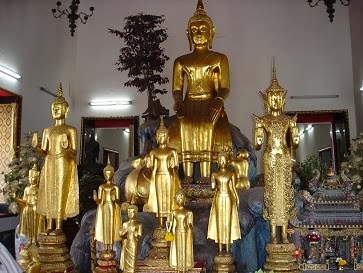Friday, February 28, 2014
The most feared fruit in the world
When you travel to Thailand, the chances are you will encounter a fruit that is so feared by hotels and offices they have designed a sign, much like a ‘no smoking’ notice, banning it from their premises. Rumour has it that unsuspecting handlers of the thing have been rendered close to unconsciousness or vomiting. But the Thais just love it - they can’t get enough of them. For them it is a supreme delicacy. They will travel miles to buy one. Specialist stalls sell nothing but the thing. It is of course the Durian. A dark green rugby shaped object with spikes - perhaps more like a miniature WWII mine with a stalk.
The reason for the hostility towards the Durian is its smell. It has been likened to rotting fish, dog shit and over ripe Camembert. The smell lingers, giving rise to suspicious glances. If you can get past the smell and into your mouth it has a buttery almond taste. I, personally, wouldn’t define it like that but then I can neither stand the taste or its texture. You have to try it, if only to say you have encountered and survived the most feared fruit in the world!
Thursday, February 27, 2014
Traditional Thai Massage
Like most Westerner’s I struggled to get my mind round this part of Thailand’s cultural code. Why is it that there are thousands of massage parlours throughout the country? Just what is the point of all this bodily manipulation? What went wrong that so many people need straightening out? My first suspicions were way off the mark! My own straightening out process started with Denis Segaller’s excellent books on Thai customs and traditions.
Traditional Thai massage is closely linked with traditional Thai medicine. Like many Thai traditions and customs they can be traced back over twenty-five hundred years to India. They predate Buddha. Quoting Denis Segaller, ‘At the Indian town of Taxila a great academy of learning was founded by Rokha Marutin. Kings and rich men sent their sons to learn all kinds of skills such as the martial and fine arts, and medicine which included as two of its branches herbal medicine and massage.’ So there you have it, it was the Indians who started it. Over the centuries these two branches of medicine survived through individual teachers. The first Buddhist monks to reach Thailand brought these skills with them – they are known collectively as ya samunphrai. Slowly, this knowledge spread and both of them became very popular as cures for all kinds of aches and pains. It was the fore-runner of a national health service. Now King Nangklao (Rama III) knew a thing or too and he became concerned this knowledge could die along with its practitioners. He gathered them all together and had this collective store of knowledge inscribed on marble tablets. And this is where I take over the story. I set out to try and find these tablets. Rumour had it they were at Wat Pho – the Temple of the Reclining Buddha. In 36 degrees of searing heat this was no easy task but after two hours searching, the wife discovered them. No signs, none of the guides we asked seemed to be aware of them [but that may have more to do with my pigeon Thai] and only by accident did we locate them in a distant pavilion. I would have thought they deserved better. Take a look.
The whole point of traditional Thai massage is to stimulate blood circulation by the application of hand pressure at certain key points of the body – it can eliminate stiffness, backache, tension and some sickness (and probably a lot more besides). The marble tablets illustrate where the key pressure points are. Now you know. The one remaining problem with all these massage spas is who trains the staff? It is largely an unregulated business. The genuine practitioners spend up to three years learning the art. It is hard to believe all practitioners devote this amount of time to acquiring the genuine skills – so be warned.
Bangkok Riots - Update 21st February 2014
Politically, Thailand is in a mess. It is a country without a functioning Government. They have a care-taker Prime Minister in Yingluck Shinawatra, the sister of exiled former premier Thaksin Shinawatra. Anti-government protesters have been rallying (or rioting as some would call it) since November 2013 trying to force Yingluck to resign. They think her departure will pave the way for a People’s Council that will implement reforms of public interest. High up the agenda is the issue of corruption. Yingluck’s administration has refused point blank to step down arguing the need to protect the democratic process. Instead it has imposed a state of emergency and went ahead with an election on 2nd February 2014.
This election was boycotted by many so the stalemate is set to continue. To the Western observer it is hard to make sense of it all. There is almost a festival atmosphere in the protesters camps but this turned nasty on 18th February when the police tried to clear them from the streets. Five were killed and many more injured. The problem is you are either a democracy or not – there is no half-way house. And this is what Suthep Thanugsuban and his People’s Democratic Reform Committee wants. Somehow he wants a non-political body to engineer change.
The photograph below is the place where a hand grenade exploded and killed two children.
Subscribe to:
Posts (Atom)

